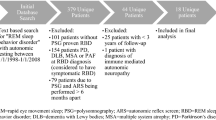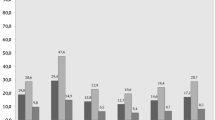Abstract
Patients with idiopathic REM sleep behavior disorder (iRBD) are at very high risk of developing neurodegenerative synucleinopathies, which are disorders with prominent autonomic dysfunction. Several studies have documented autonomic dysfunction in iRBD, but large-scale assessment of autonomic symptoms has never been systematically performed. Patients with polysomnography-confirmed iRBD (318 cases) and controls (137 healthy volunteers and 181 sleep center controls with sleep diagnoses other than RBD) were recruited from 13 neurological centers in 10 countries from 2008 to 2011. A validated scale to study the disorders of the autonomic nervous system in Parkinson's disease (PD) patients, the SCOPA-AUT, was administered to all the patients and controls. The SCOPA-AUT consists of 25 items assessing the following domains: gastrointestinal, urinary, cardiovascular, thermoregulatory, pupillomotor, and sexual dysfunction. Our results show that compared to control subjects with a similar overall age and sex distribution, patients with iRBD experience significantly more problems with gastrointestinal, urinary, and cardiovascular functioning. The most prominent differences in severity of autonomic symptoms between our iRBD patients and controls emerged in the gastrointestinal domain. Interestingly, it has been reported that an altered gastrointestinal motility can predate the motor phase of PD. The cardiovascular domain SCOPA-AUT score in our study in iRBD patients was intermediate with respect to the scores reported in PD patients by other authors. Our findings underline the importance of collecting data on autonomic symptoms in iRBD. These data may be used in prospective studies for evaluating the risk of developing neurodegenerative disorders.
Similar content being viewed by others
References
Schenck CH, Bundlie SR, Ettinger MG, Mahowald MW (1986) Chronic behavioral disorders of human REM sleep: a new category of parasomnia. Sleep 9:293–308
Iranzo A, Molinuevo JL, Santamaria J, Serradell M, Martí MJ, Valldeoriola F, Tolosa E (2006) Rapid-eye-movement sleep behaviour disorder as an early marker for a neurodegenerative disorder: a descriptive study. Lancet Neurol 5:572–577
Postuma RB, Gagnon JF, Vendette M, Fantini ML, Massicotte-Marquez J, Montplaisir J (2009) Quantifying the risk of neurodegenerative disease in idiopathic REM sleep behavior disorder. Neurology 72:1296–1300
Iranzo A, Tolosa E, Gelpi E, Molinuevo JL, Valldeoriola F, Serradell M, Sanchez-Valle R, Vilaseca I, Lomeña F, Vilas D, Lladó A, Gaig C, Santamaria J (2013) Neurodegenerative disease status and post-mortem pathology in idiopathic rapid-eye-movement sleep behaviour disorder: an observational cohort study. Lancet Neurol 12:443–453
Valappil RA, Black JE, Broderick MJ, Carrillo O, Frenette E, Sullivan SS, Goldman SM, Tanner CM, Langston JW (2010) Exploring the electrocardiogram as a potential tool to screen for premotor Parkinson’s disease. Mov Disord 25:2296–2303
Postuma RB, Lanfranchi PA, Blais H, Gagnon JF, Montplaisir JY (2010) Cardiac autonomic dysfunction in idiopathic REM sleep behavior disorder. Mov Disord 25:2304–2310
Sorensen GL, Kempfner J, Zoetmulder M, Sorensen HB, Jennum P (2012) Attenuated heart rate response in REM sleep behavior disorder and Parkinson’s disease. Mov Disord 27:888–894
Miyamoto T, Miyamoto M, Suzuki K, Nishibayashi M, Iwanami M, Hirata K (2008) 123I-MIBG cardiac scintigraphy provides clues to the underlying neurodegenerative disorder in idiopathic REM sleep behavior disorder. Sleep 31:717–723
Postuma RB, Gagnon JF, Vendette M, Montplaisir JY (2009) Markers of neurodegeneration in idiopathic REM sleep behavior disorder and Parkinson's disease. Brain 132:2298–2307
Postuma RB, Lang AE, Massicotte-Marquez J, Montplaisir J (2006) Potential early markers of Parkinson's disease in idiopathic REM sleep behavior disorder. Neurology 66:845–851
Postuma RB, Gagnon JF, Pelletier A, Montplaisir J (2013) Prodromal autonomic symptoms and signs in Parkinson’s disease and dementia with Lewy bodies. Mov Disord 28:597–604
Visser M, Marinus J, Stiggelbout AM, Van Hilten JJ (2004) Assessment of autonomic dysfunction in Parkinson’s disease: the SCOPA-AUT. Mov Disord 19:1306–1312
American Academy of Sleep Disorders (2005) International Classification of Sleep Disorders–2. American Academy of Sleep Disorders, Westchester
Folstein MF, Folstein SE, McHugh PR (1975) “Mini-mental state”: a practical method for grading the cognitive state of patients for the clinician. J Psychiatr Res 12:189–198
Hughes AJ, Daniel SE, Kilford L, Lees AJ (1992) Accuracy of clinical diagnosis of idiopathic Parkinson’s disease: a clinico-pathological study of 100 cases. J Neurol Neurosurg Psychiatry 55:181–184
Boeve BF (2010) REM sleep behavior disorder: updated review of the core features, the REM sleep behavior disorder-neurodegenerative disease association, evolving concepts, controversies, and future directions. Ann N Y Acad Sci 1184:15–54
Claassen DO, Josephs KA, Ahlskog JE, Silber MH, Tippmann-Peikert M, Boeve BF (2010) REM sleep behavior disorder preceding other aspects of synucleinopathies by up to half a century. Neurology 75:494–499
Jain S (2011) Multi-organ autonomic dysfunction in Parkinson's disease. Parkinsonism Relat Disord 17:77–83
Idiaquez J, Roman GC (2011) Autonomic dysfunction in neurodegenerative dementias. J Neurol Sci 305:22–27
Wenning GK, Stefanova N (2009) Recent developments in multiple system atrophy. J Neurol 256:1791–1808
Ferini-Strambi L, Oldani A, Zucconi M, Smirne S (1996) Cardiac autonomic activity during wakefulness and sleep in REM sleep behavior disorder. Sleep 19:367–369
Fantini ML, Michaud M, Gosselin N, Lavigne G, Montplaisir J (2002) Periodic leg movements in REM sleep behavior disorder and related autonomic and EEG activation. Neurology 59:1889–1894
Postuma RB, Gagnon JF, Vendette M, Montplaisir JY (2009) Markers of neurodegeneration in idiopathic rapid eye movement sleep behaviour disorder and Parkinson’s disease. Brain 132:3298–3307
Jennum P, Mayer G, Ju YE, Postuma R (2013) Morbidities in rapid eye movement sleep behavior disorders. Sleep Med 14:782–787
Labate A, Salsone M, Novellino F, Morelli M, Sturniolo M, Gambardella A, Quattrone A (2011) Combined use of cardiac m-i123-iodobenzylguanidine scintigraphy and (1)(2)(3)I-fp-cit single photon emission computed tomography in older adults with rapid eye movement sleep behavior disorder. J Am Geriatr Soc 59:928–929
Miyamoto T, Miyamoto M, Inoue Y, Usui Y, Suzuki K, Hirata K (2006) Reduced cardiac 123I-MIBG scintigraphy in idiopathic REM sleep behavior disorder. Neurology 67:2236–2238
Frauscher B, Nomura T, Duerr S, Ehrmann L, Gschliesser V, Wenning GK, Wolf E, Inoue Y, Högl B, Poewe W (2012) Investigation of autonomic function in idiopathic REM sleep behavior disorder. J Neurol 259:1056–1061
Kashihara K, Imamura T, Shinya T (2010) Cardiac 123I-MIBG uptake is reduced more markedly in patients with REM sleep behavior disorder than in those with early stage Parkinson’s disease. Parkinsonism Relat Disord 16:252–255
Nomura T, Inoue Y, Kagimura T, Nakashima K (2013) Clinical significance of REM sleep behavior disorder in Parkinson’s disease. Sleep Med 14:131–135
Romenets SR, Gagnon JF, Latreille V, Panniset M, Chouinard S, Montplaisir J, Postuma RB (2012) Rapid eye movement sleep behavior disorder and subtypes of Parkinson’s disease. Mov Disord 27:996–1003
Abbott RD, Petrovitch H, White LR, Masaki KH, Tanner CM, Curb JD, Grandinetti A, Blanchette PL, Popper JS, Ross GW (2001) Frequency of bowel movements and the future risk of Parkinson’s disease. Neurology 57:456–462
Braak H, de Vos RA, Bohl J, Del Tredici K (2006) Gastric alpha-synuclein immunoreactive inclusions in Meissner’s and Auerbach’s plexuses in cases staged for Parkinson’s disease-related brain pathology. Neurosci Lett 396:67–72
Wakabayashi K, Takahashi H, Takeda S, Ohama E, Ikuta F (1989) Lewy bodies in the enteric nervous system in Parkinson’s disease. Arch Histol Cytol 52:191–194
Nihei K, Takahashi A, Koto B, Mihara B, Morita Y, Isozumi K, Ohta K, Muramatsu K, Gotoh J, Yamaguchi K, Tomita Y, Sato H, Seki M, Iwasawa S, Suzuki N (2012) REM sleep behavior disorder in Japanese patients with Parkinson’s disease: a multicenter study using the REM sleep behavior disorder screening questionnaire. J Neurol 259:1606–1612
Unger MM, Möller JC, Mankel K, Schmittinger K, Eggert KM, Stamelou M, Stiasny-Kolster K, Bohne K, Bodden M, Mayer G, Oertel WH, Tebbe JJ (2011) Patients with idiopathic rapid-eye-movement sleep behavior disorder show normal gastric motility assessed by the 13C-octanoate breath test. Mov Disord 26:2559–2563
Unger MM, Möller JC, Mankel K, Eggert KM, Bohne K, Bodden M, Stiasny-Kolster K, Kann PH, Mayer G, Tebbe JJ, Oertel WH (2011) Postprandial ghrelin response is reduced in patients with Parkinson’s disease and idiopathic REM sleep behaviour disorder: a peripheral biomarker for early Parkinson’s disease? J Neurol 258:982–990
Conflicts of interest
The authors report no disclosures relevant to the manuscript. L. Ferini-Strambi has received honoraria for serving on scientific advisory boards from UCB, Mundipharma, Menarini. Full financial disclosure for the previous 12 months W. Oertel has received honoraria for consultancy and for serving on scientific advisory boards; travel support from UCB; and honoraria for consultancy and lecture fees from Teva, Novartis, GlaxoSmithKline, Boehringer Ingelheim, Orion Pharma, and Merck Serono. Y. Dauvilliers has received funds for speaking and board engagements with UCB, Cephalon, Jazz, and Bioprojet. R.B. Postuma has received research funds from the Canadian Institute of Health Research, Fonds de la Recherche en Sante Quebec, The Webster Foundation, and the Drummond Foundation, as well as funds for travel and speaker fees from Novartis Canada and Teva Neurosciences. A. Iranzo had speaking and board engagements with UCB and Sanofi-Synthelabo. I Arnulf received honoraria for a speaking engagement and board from UCB Pharma. I. Arnulf received honoraria from UCB Pharma and Jazz for a speaking engagement and consultancy. B. Hogl has received honoraria for speaking, serving on an advisory board, or consulting from UCB, Mundipharma, BI, GSK, Respironics, Sanofi, Lundbeck, and Jazz; and a grant to institution from UCB, and travel support from Habel Medizintechnik and Vivisol, Austria. K. Sonka served on a scientific advisory board for UCB Pharma, received lecture fees from Ipsen, Pfizer, UCB Pharma, and GlaxoSmithKline, and participated in clinical trials managed by UCB Pharma, Bioprojet, and Eisai; and received research support from Charles University in Prague (PRVOUK P26/LF1/4). B. Frauscher has had speaking engagements with UCB and received a competitive research grant from the Austrian Science Fund (KLI 236), grant of the Nationalbank of Austria (15127). M. Unger received grants from the Micheal J. Fox Foundation for Parkinson’s Research and from the International Parkinson Fonds Germany. K. Stiasny-Kolster has received honoraria for serving on the scientific advisory boards for Boehringer Ingelheim, and UCB, and has received honoraria for speaking engagements sponsored by UCB and Boehringer Ingelheim. J. Montplaisir received funds from Merck and GlaxoSmithKline, and has received honoraria for consultancy from Jazz, Merck, Valeant, Servier, and Impac laboratories. S. Marelli, R. Manni, T. Miyamoto, M.L. Fantini, M. Puligheddu, P. Jennum, J. Santamaria, M. Zucconi, M.V·P. Rancoita, S. Leu-Semenesceu, M. Terzaghi, M. Miyamoto, A. Desautels, C. Wolfson, and A. Pelletier have nothing to disclose.
Patient consent
Obtained.
Ethical standard
Each sleep center obtained approval from its local institutional review board.
Author information
Authors and Affiliations
Corresponding author
Rights and permissions
About this article
Cite this article
Ferini-Strambi, L., Oertel, W., Dauvilliers, Y. et al. Autonomic symptoms in idiopathic REM behavior disorder: a multicentre case–control study. J Neurol 261, 1112–1118 (2014). https://doi.org/10.1007/s00415-014-7317-8
Received:
Revised:
Accepted:
Published:
Issue Date:
DOI: https://doi.org/10.1007/s00415-014-7317-8




